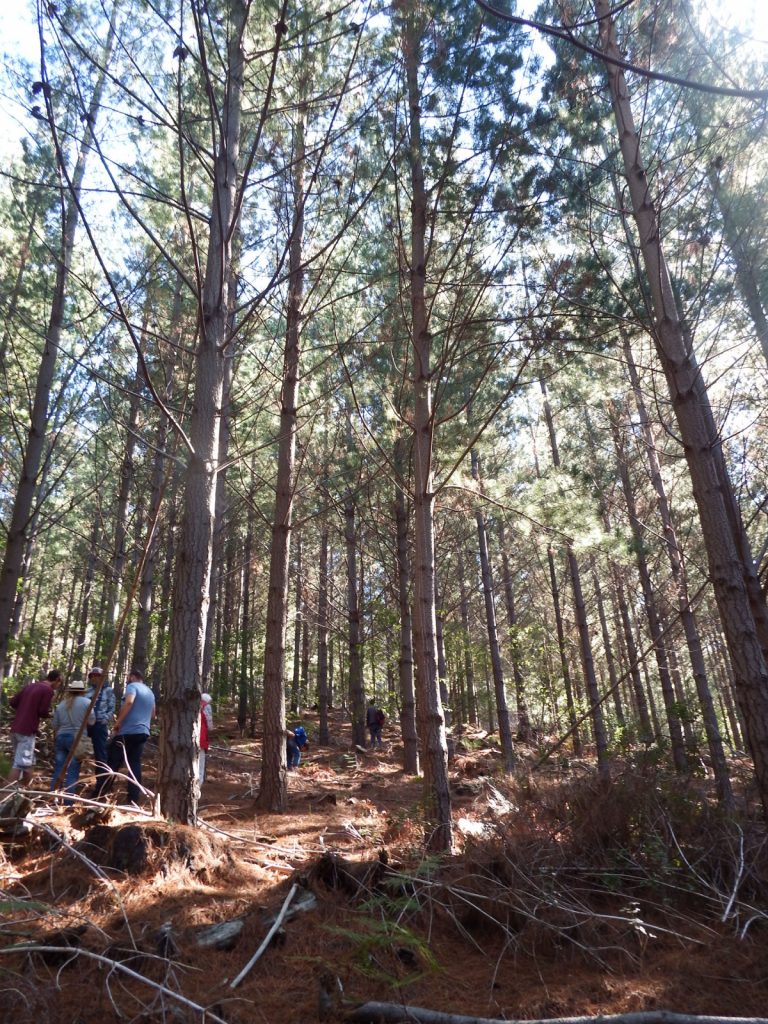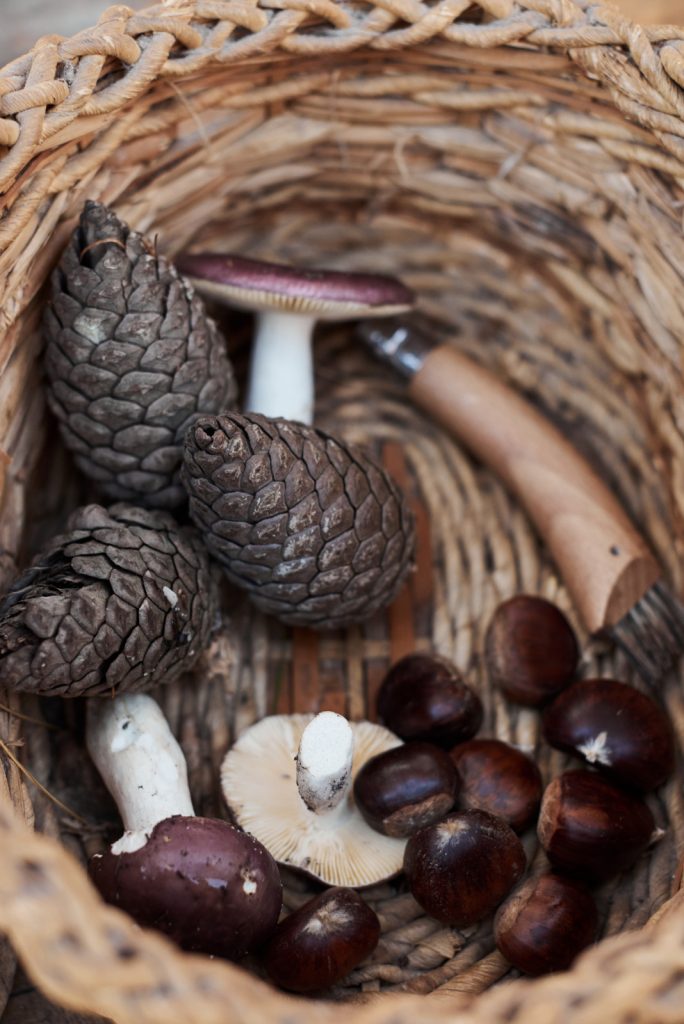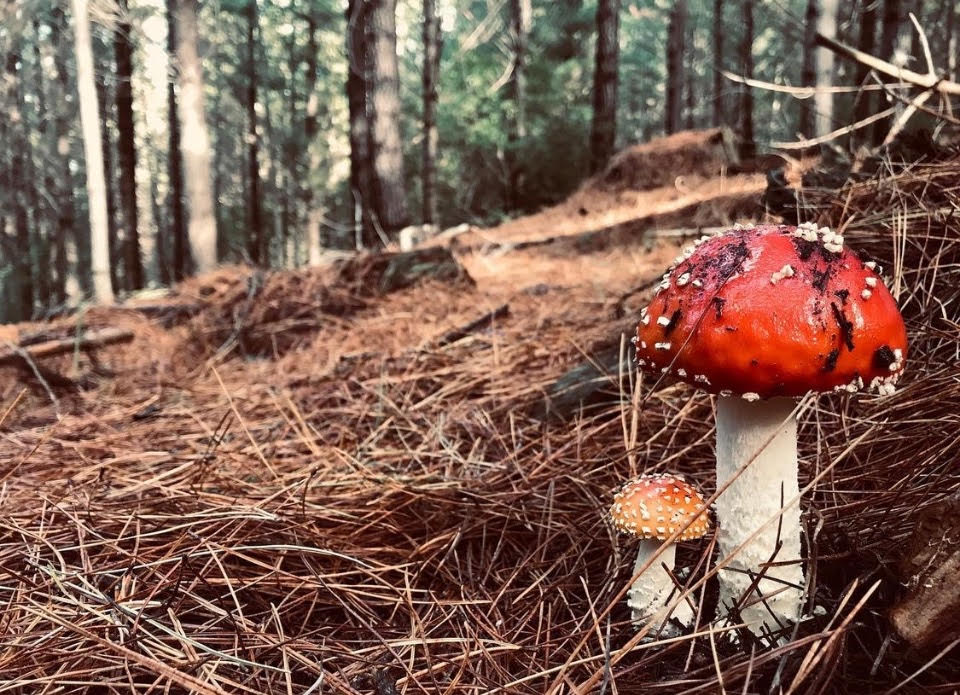At the Bel Ombre Meadows in Constantia a mushroom foraging expedition turns up a good bounty of edibles the participants divide among themselves. Photo: Veld and Sea
You would expect a mushroom foraging expedition to take place on the outskirts of the city. But a group of 20 meet in a small wooded area called the Bel Ombre Meadows in Constantia, Cape Town.
Foraging for food in posh suburbs makes sense because the locals probably don’t scrounge forests for their porcini — but this isn’t the reason for the choice of the location. As our mushroom foraging guide, Justin Williams, explains, the combination of different types of trees and the south-facing slope of the land allows rain to be more readily retained that makes this little wooded area an ideal spot to find mushrooms.
This foraging event has been organised by Veld & Sea, a company based at the Good Hope Gardens Nursery in Cape Point where they run workshops largely centred on foraging for food. Founded by Roushanna Gray, who describes herself as a wild food artist, foodie and avid forager, her workshops and tours sell-out quickly. Having missed out on more summer orientated foraging along the seashores, I booked for this mushroom foraging event a month in advance without knowing where it would be held. This is announced a few days ahead of the hunt, adding to the excitement.

Why is it that I want to forage for food so badly that I would be willing to part with R600 to look for mushrooms in the rain? The answer to this question only comes to me when I pluck the first edible mushroom out of the wet ground and gently flick off the dirt from its spongy form. The waves of delight this evokes is biologically programmed into humans — our survival once depended on foraging.
“It’s disappointing to discover that truffle oil is a fallacy.”
For Williams this drive propelled him from early on. “It started when I was child and I went with a basket in hand looking for mushrooms with my father. We found lots but when we looked them up, none of them were edible. This was humbling,” he recalls.
Since this event, he has been driven to find and collect edible mushrooms. It can make for a good hobby for all ages and fitness levels. Our two-hour forage is done in walking shoes and is slow because you need to keep your eyes peeled to the ground to spot those ever-elusive brown tops. You don’t need to be fit or sporty. Just persistent.
When Williams asks the participants to introduce themselves, it becomes clear we are largely in the company of foodies, who appreciate good ingredients. There are three professional chefs among us, who it turns out later have a really good nose for mushrooms and are largely responsible for filling the baskets with fresh bounty.
We are risk-takers too. Williams confirms that there are a lot of poisonous mushrooms out there that should be avoided at all costs. He outlines the characteristics poisonous mushrooms are likely to have.
“You must look out for white gills (the papery lines underneath the mushroom cap) and what they call a ‘skirt’ — a line that runs around the stem of the mushroom. Usually edible mushrooms are spongy underneath the caps, so that is typically a good indication that you can eat them,” he says.
Like most hunting expeditions, it starts off slow and our first finds are poisonous mushrooms. Williams tells us to check the genus before eating any freshly foraged mushrooms.
Mushrooms don’t want to be found; it takes some practice to detect the brown caps hiding in the long grass or wooded areas where they blend in with the vegetation. We largely gather two types, the bay bolete (Imleria badia) and the cèpe or porcini (Boletus edulis). Neither can be found at your local supermarket; sometimes you can find dried porcini and the fresh kind perhaps at some farmers’ markets. The group glows with pride as the basket fills up.

It is fascinating to discover the close relationship between mushrooms and trees. Williams alerts us to this vast network beneath the ground; a fungal mass called mycelium, which is linked by delicate threads to the roots of trees. Mushrooms are protrusions from the mycelium that manifest because of a “shock” to the system, which is usually rain and thunder, according to Williams. He advises foraging for mushrooms a few after days of consistent rain. Winter is the best time for foraging in the Western Cape, while this would differ for other parts of the country, where summer is the rainy season.
“There hasn’t been much rain in Cape Town, the rainy season has come late. Normally May would be a good time of year to go foraging,” says Williams.
“There are plenty of variables at play, but ultimately every macro-fungus has a set of parameters that determine its fruiting. The trick is understanding what is required to fruit, for which species and when.”
Foraging gets you more in touch with the ebb and flow of the natural world. Foraging for food at a supermarket is not going to deliver on this, even if a two for the price of one special draws your attention to a vegetable being in season.

Williams is involved in marketing crypto currency by day but appears to have a vast knowledge of mushroom species; he has a name for whatever manner of fungus we pull out of the ground. Perhaps his on-screen life finds balance in the forests. An amusing story about how his grandfather’s life was saved by a Kalahari truffle suggests that he was destined for a life intertwined with mushrooms.
Mention of the Kalahari truffle segues into a conversation about indigenous mushrooms. Most of those found in Cape Town are derived from trees from Europe — pine, poplar and oak trees. Indigenous mushrooms such as the amakhowe, which grow in KwaZulu-Natal, might be easier to come across than the Kalahari Truffle, which grows in desert settings. Catch Cook, a YouTube channel that charts the adventures of a forager in KwaZulu-Natal, has a post dedicated to finding amakhowe, which he is seen plucking next to a highway.
“They are probably the tastiest mushrooms you will ever eat in your life,” coos Ray of Catch Cook preparing his bounty back at home.
Foraging has grown in popularity in South Africa. It is not exactly linked to rising food prices, although that might increase interest in it, but rather an awareness of the quality of ingredients, how far they have travelled and the effect of that on the environment and perhaps with digital spheres creeping into every corner of our daily lives, present the opportunity to immerse yourself and be in tune with nature.
“People are very surprised that there’s actually so much food around. We’ve actually moved so much or so far away from our roots of being able to go out into nature and gather or hunt for our food that it seems quite strange now that you would watch you walk off the beaten path and go pick out a dirty old mushroom in the bush where is this is actually a delicious meal,” says Williams.
Two of the people on our mushroom hunt explain that after working hard on a project they needed time away from screens. At R600 a ticket, this is a pursuit for the privileged but people of all walks of life, armed with the right knowledge, can forage whether for pleasure or out of necessity.
Williams lists several locations in the Western Cape where people can forage after rains. The Newlands forest in Cape Town is the source of Laetiporus sulphureus, commonly called “chicken of the woods”. It is so named because of its bright orange-yellow body that resembles a chicken’s neck. It is found protruding from stumps, logs and trees. Stellenbosch and the Wineland areas are also good hunting grounds.
Williams suggests that we should try to grow our own mushrooms at home such as oyster mushrooms, which are easy to care for. It’s disappointing to discover that truffle oil is a fallacy.
“You can make truffle oil with shavings of the truffle but it will only keep in the fridge for a few days. Mostly they use peroxide, which tastes like truffle to give oils the truffle flavour,” says Williams.
The highlight of the day is discovering two large bay boletes in open grass a distance from the pine forest. The group circles them excitedly, snapping photographs with their phones. The largest of the two has passed its sell-by date. The caps often turn up, like umbrellas when a gust of wind turns them inside out, when they are no longer good for eating.
The other one is still healthy and is delicately pulled out of the ground before the soil behind is dusted off. It is added to our basket, which is looking much healthier than we expected — we were warned that some forages only bear a few mushrooms.
Of course, the proof is in the eating and our two-hour hunt concludes with a light mushroom-themed lunch. Mushrooms from earlier foraging trips are combined with other vegan and foraged ingredients to produce a mushroom flavoured tea, mushroom paté served on toast, mushroom soup and a chocolate brownie with mushrooms.
But the best part of the forage is leaving with a small collection of fresh mushrooms. Mine are lovingly cleaned and form the crowning glory of a risotto for that evening’s dinner. It is the best mushroom risotto, particularly as it brings to mind walking through the misty Bel Ombre meadows and the excitement of spotting a large mushroom cap.
Visit Veld & Sea at www.veldandsea.com. Find out more about Justin Williams or buy his guide to mushrooms in South Africa at www.mushroomhunting.com Visit Catch Cook on Youtube to find out about foraging in Kwazulul Natal: https://www.youtube.com/watch?v=7OOb5KyHlXU